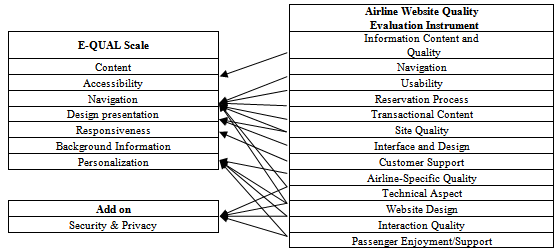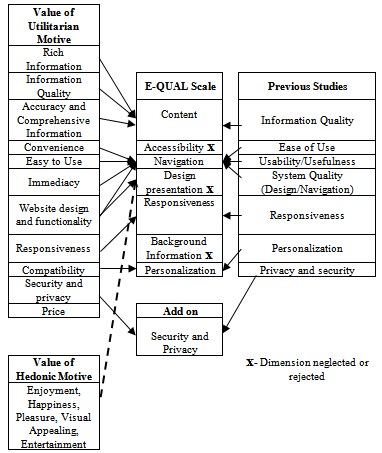| [1] | eMarketer, “Asia-Pacific is to lead the world in online sales by 2013”, Retrieved on 27 December 2012 from http://www.newmediatrendwatch.com/news/1089-asia-pacific-is-to-lead-the-world-in-online-sales-by-2013. |
| [2] | Phocuswright, “Low-Cost Carrier Lead Airline Market Growth in Asia Pacific”,http://www.phocuswright.com/research_updates/low-cost-carriers-lead-airline-market-growth-in-asia-pacific, 2012. |
| [3] | H. Haghtalab, Z. G. Tarzeh, and T. Nabizadeh, “Investigating the Effects of Electronic Satisfaction Factors on Forming Electronic Satisfaction of Website Services in Tourism Industry”, Research Journal of Recent Sciences, Vol. 1 (11), 2012, pp.1-8. |
| [4] | M. M. Bozorgi, “Measuring Service Quality of the Airline using SERVQUAL model”, Lulea Univ. Technology, 2006. |
| [5] | J. E. Francis, and L. White, “PIRQUAL: A Scale for Measuring Customer Expectations and Perceptions of Quality in Internet Retailing”, Proceedings of the 2002 American Marketing Association Winter Educators’ Conference: Marketing Theory and Applications, Vol. 13, 2002, pp.263-270. |
| [6] | E. T. Loiacono, R. T. Watson, and D. L. Goodhue, “WEBQUAL: A Measure of Website Quality”, 2002 Marketing educators’ conference: Marketing theory and applications, Vol. 13, 2002, pp. 432–437. |
| [7] | L. C. Schaupp, and F. Belanger, “A Conjoint Analysis of Online Consumer Satisfaction”, Journal of Electronic Commerce, Vol.6 (2), 2005, pp.95-111. |
| [8] | D. M. Szymanski, and R. T. Hise, “E-satisfaction: An Initial Examination”, Journal of Retailing, Vol.76 (3), 2000, pp.309–322. |
| [9] | M. Wolfinbarger, and M. Gilly, “Etailq: Dimensionalizing, Measuring and Predicting Etail Quality”, Journal of Retailing, Vol.79, issue.3, 2003, pp.183-198. |
| [10] | B. Yoo, and N. Donthu, “Developing a Scale to Measure Perceived Quality of an Internet Shopping Site (SITEQUAL)”, Quarterly Journal of Electronic Commerce, Vol. 2 No. 1, 2001, pp.31-46. |
| [11] | V. A. Zeithaml, A. Parasuraman, and A. Malhotra, “A Conceptual Framework for Understanding E-Service Quality: Implications for Future Research and Managerial Practice”, MSI Working Paper Series, Cambridge, report No. 00-115, 2000. |
| [12] | B. Kurniawan, “Factors Affecting Customer Satisfaction in Purchase Decision on Ticket Online: A Case Study in Air Asia”, Online Available: Pg 85 from http://repository.uinjkt.ac.id/dspace/handle/123456789/3312, 2010. |
| [13] | M. D. Clemes, C. Gan, T. H. Kao, and M. Choong, “An Empirical Analysis of Customer Satisfaction in International Air Travel” Innovative Marketing, Vol. 4(2), 2008, pp. 50-62. |
| [14] | E. Yeoh, and J. L. C. Kim, “Malaysian Low Cost Airlines: Key Influencing Factors on Customers' Repeat Purchase Intention”, World Applied Sciences Journal 12 (Special Issue of Tourism & Hospitality, 2011, pp.35-43. |
| [15] | G.C. Saha, Theingi, “Service Quality, Satisfaction, and Behavioural Intentions: A Study of Low-Cost Airline Carriers in Thailand”, Manag. Serv. Qual., Vol.19 (3), 2009, pp.350-372. |
| [16] | P. Oyewole, M. Sankaran, and, P. Choudhury, “Marketing Airline Services in Malaysia: A Consumer Satisfaction Orientation Approach” Innovative Marketing, Vol. 3, Issue 1, 2007, pp.56-70. |
| [17] | R. Archana, and M. V. Subha, “A Study on Service Quality and Passenger Satisfaction on Indian Airlines”, International Journal of Multidisciplinary Research. Vol. 2 (2), 2012, pp.50-63. |
| [18] | A. A. M. Ariffin, A. H. M. Salleh, N. A. Aziz, and A. A. Asbudin, “Service Quality and Satisfaction for Low Cot Carriers”, International Review of Business Research Papers, Vol. 6(1), 2010, pp.47-56. |
| [19] | J. Munusamy, and S. Chelliah, “An Investigation of Impact of Service Strategy on Customer Satisfaction in the Budget Airline Industry in Malaysia: A Case Study of Air Asia”, Contemporary Marketing Review, Vol.1 (1), 2011, pp.1-13. |
| [20] | J. Munusamy, S. Chelliah, and S. Pandian, “Customer Satisfaction Delivery in Airline Industry in Malaysia: A Case of Low Cost Carrier”, Australian Journal of Basic and Applied Sciences, Vol.5 (11), 2011, pp.718-723. |
| [21] | R. Lindstrøm Jensen, “Delivering Excellent Service Quality in Low Cost Aviation: A Process Perspective on the Passenger Market in Copenhagen Airport”, International Marketing & Management.Thesis, Copenhagen Business School, 2009. |
| [22] | P. Malighetti, S. Paleari, and R. Redondi, “Pricing Strategies of Low-Costs Airlines: The Ryanair Case”, Journal of Air Transport Management, Vol.15 (4), 2009, pp.195-203. |
| [23] | Y. K. Kim, and H. R. Lee, “Customer Satisfaction Using Low Cost Carriers”. Tourism Management, Vol.32, Issue 2, 2011, pp.235-243. |
| [24] | C. Shchiglik, and S. J. Barnes, “Evaluating Website Quality in the Airline Industry”, Journal of Computer Information Systems, Vol.44 (3), 2004, pp.17-25. |
| [25] | C. Hadi, “Buying Environment Characteristics in the Context of E-service within Airlines Companies in Jabodetabek”, Project Paper, Binus University Jakarta, 2010. |
| [26] | T. C. Lau, C. L. Kwek, and H. P. Tan, “Airline e-Ticketing Service: How e-Service Quality and Customer Satisfaction Impacted Purchase Intention”, International Business Management, Vol.5 (4), 2011, pp.200-208. |
| [27] | F. Lee, and W. Wu, “Moderating Effects of Technology Acceptance Perspectives on E-Service Quality Formation: Evidence from Airline Websites in Taiwan”, Expert Systems with Applications, Vol. 38 (6), 2011, pp.7766–7773. |
| [28] | V. D, Merwe, “The Impact of Electronic Service Quality Dimensions on Customer Satisfaction”, Bussiness Management Theses. Univ Nelson Mandela Metropolitan, 2011. |
| [29] | S. Bukhari, A. Ghoneim, and C. Dennis, “Understanding the Factors that attract Travellers to Buy Airline Tickets Online in Saudi Arabia.” European, Mediterranean & Middle Eastern Conference on Information Systems, 2012, pp.619-628. |
| [30] | F. P. J. Jansen, “German Sunday Shoppers in Roermond: Shopping Motivations and Choice Criteria”, thesis, Marketing Department, Tilburg University, 2006. |
| [31] | J. E. Francis, and L .White, “Value across Fulfillment-product Categories of Internet Shopping”, Managing Service Quality, Vol. 14 Iss: 2/3, 2004, pp.226 –234. |
| [32] | J. E. Francis, “Category-specific RECIPEs for Internet Retailing Quality”, Journal of Services Marketing, Vol. 23 Iss: 7, 2009, pp.450 – 461. |
| [33] | K. Nusair, and J. Kandampully, “The Antecedents of Customer Satisfaction with Online Travel Services: A Conceptual Model”, Europe Business Review, Vol.20 (1), 2008, pp.4-19. |
| [34] | D. Buhalis, “eAirlines: Strategic and tactical use of ICTS in the Airline Industry”, Information & Management, Vol.41 (7), 2004, pp.805-825. |
| [35] | M. F. M. Sam, and M. N. H. Tahir, “Website Quality and Consumer Online Purchase Intention of Air Ticket”, International Journal of Basic & Applied Sciences, IJBAS, Vol.9, No.10, 2009, pp.20-25. |
| [36] | C. N. L. Tan, K. J. Gwee, T. H. Ng, and Y. S. Lim, “Predictors of Business-To-Consumer Electronic Commerce Usage among Online Consumers in Malaysia”, 2nd International Conference on Business and Economic Research Proceeding, 2011, pp.562-580. |
| [37] | S. A. Kaynama, and C. I. Black, “A Proposal to Assess the Service Quality of Online Travel Agencies: An Exploratory Study”, Journal of Professional Services Marketing, Vol.21 (1), 2000, pp.63–89. |
| [38] | C. Ho, and Y. Lee, “The Development of an E-travel Service Quality Scale”, Tourism Management, Vol.28 (6), 2007, pp.1434-1449. |
| [39] | J. E. Mills, and A. M. Morrison, “Measuring Customer Satisfaction with Online Travel”, Information and Communication Technology 2003: Proceedings of the International Conference in Helsinki, Finland, 2003, pp.10-19. |
| [40] | W. G. Kim, and H. Y. Lee, “Comparison of Web Service Quality between Online Travel Agencies and Online Travel Suppliers”, Journal of Travel & Tourism Marketing, Vol.17 (2-3), 2004, pp.105-116. |
| [41] | H. Murphy, and A. Leung, “E-service quality, perceived value, satisfaction and loyalty: an investigation of a third party website”, Proceedings of the EUROCHRIE Conference, 2010. |
| [42] | M. Moharrer, H. Tahayori, A. Albadavi, S. H. Zegori, and, H. Perzon, “Satisfaction in E-Tourism A Case of European Online Customers”. Proceedings of the IADIS e-Commerce 2006 International Conference, 2006, pp.303 – 307. |
| [43] | A. Parasuraman, V. A Zeithaml, and L. L. Berry, “SERVQUAL: A Multiple-Item Scale for Measuring Consumer Perceptions of Service Quality”, Journal of Retailing, Vol. 64 No.1, 1988, pp.12-40. |
| [44] | G. Bressolles, “Electronic Service Quality: Netqual – Proposition of a Measurement Scale to Commercial Websites and Moderating Effects”, Research and Applications in Marketing, Vol.21 (3), 2006, pp.19-45. |
| [45] | N. Ahituv, and Gil. Amoray, “Website Evaluation in the Tourism Industry: Evaluating Quality of Customer Service in Airline B2C Systems”, Mgt. Sc. thesis, Tel Aviv Univ, 2006. |
| [46] | G. Apostolou, and A. A. Economides, “Airlines websites evaluation around the world”, Proceedings of SPRINGER Communications in Computer and Information Science (CCIS) 19, 2008, pp.611-617. |
| [47] | S. Alwahaishi, A. Nehari, and V. Snasel, "Electronic Commerce Growth in Developing Countries: Barriers and Challenges", Proceedings of the IEEE International Conference on Networked Digital Technologies, 2009, pp.225-232. |
| [48] | S. Alwahaishi, and V. Snasel, “Assessing the LCC websites quality”, Proceedings - 9th RoEduNet IEEE International Conference, RoEduNet, 2010, pp.107-111. |
| [49] | T. L. Childers, C. L. Carr, J. Peck, and S. Carson, “Hedonic and utilitarian motivations for online retail shopping behavior”, Journal of Retailing, Vol.77 (4), 2001, pp.511–535. |
| [50] | M. Conyette, “Demographics for Segmentation in Online Travel”, International Journal of Trade, Economics and Fiance, Vol. 2, no. 1, 2011, pp. 93-98. |
| [51] | W. C. Tsao, and H. R. Chang, “Exploring the Impact of Personality Traits on Online Shopping Behavior”, African J. Business Management, Vol. 4 (9), 2010, pp.1800-1812. |
| [52] | S. Beldona, A. M. Morrison, J. Oleary, “Online Shopping Motivations and Pleasure Travel Products: A Correspondence Analysis”, Tourism Management, Vol.26 (4), 2005, 561-570. |
| [53] | P. L. To, C. C. Liao, and T. H. Lin, “Shopping Motivations on Internet: A Study based on Utilitarian and Hedonic Value”, Technovation, Vol.27 (12), 2007, pp.774-787. |
| [54] | N. Delafrooz, L. H. Paim, S. A. Haron, S. M. Sidin, and A. Khatibi, “Factors Affecting Students' Online Shopping Attitude and Purchase Intention”, African Journal of Business Management, Vol. 3 (5), 2009, pp. 200-209. |
| [55] | G. C. Moore, and I. Benbasat, “Development of an Instrument to Measure the Perceptions of Adopting an Information Technology Innovation”, Information Systems Research, Vol.2 (3), 1991, pp.192-222. |
| [56] | E. T. K. Lim, D. Cyr, and C. W. Tan, “Untangling Utilitarian and Hedonic Consumption Behaviors in Online Shopping”, In Proceedings of the 16th Pacific Asia Conference on Information Systems (PACIS’12), 2012. |
| [57] | R. Vázquez-Casielles, “Virtual Travel Agencies: Developing a Roadmap for Competitiveness”, online available: http://www.wharton.universia.net/index.cfm?fa=viewArticle&id=1856&language=english, 2010. |
| [58] | E. C. Hirschman, and M. B. Holbrook, “Hedonic Consumption: Emerging Concepts, Methods and Propositions”, Journal of Marketing, Vol.46 (3), 1982, pp.92-101. |
| [59] | B. J. Babin, W. R. Darden, and M. Griffen, “Work and/or Fun: Measuring Hedonic and Utilitarian Shopping Value”, Journal of Consumer Research, vol.20 (4), 1994, pp.644–656. |
| [60] | S. Cai, and Y. Xu, “Effects of Outcome, Process and Shopping Enjoyment on Online Consumer Behaviour”, Electronic Commerce Research and Applications, Vol.5, 2006, 272-281. |
| [61] | A. Bhatnagar, and S. Ghosh, “A Latent Class Segmentation Analysis of E-Shoppers”, Journal of Business Research, vol.57 (7), 2004, pp.758-767. |
| [62] | O. T. Ahtola, “Hedonic and Utilitarian aspects of Consumer Behaviour; An Attitudinal Perspective”, Advances in Consumer Research, Vol.12, 1985, pp.7-10. |
| [63] | L. Zhou, L. Dai, and D. Zhang, “Online Shopping Acceptance Model: A critical survey of consumer factors in online shopping”, J Electronic Commerce Research, Vol.8, No.1, 2007, pp.41-62. |

 Abstract
Abstract Reference
Reference Full-Text PDF
Full-Text PDF Full-text HTML
Full-text HTML



